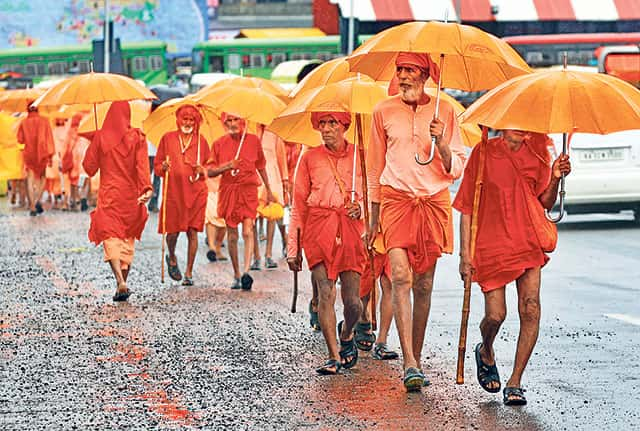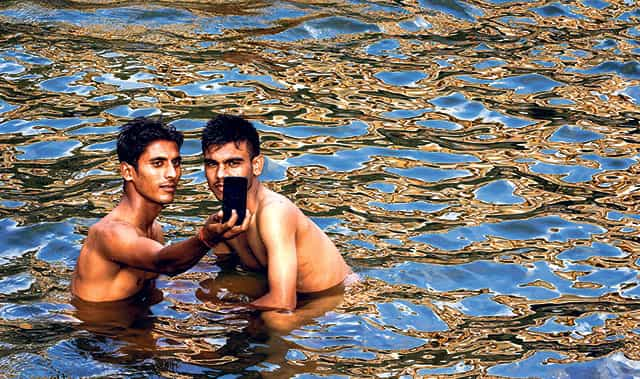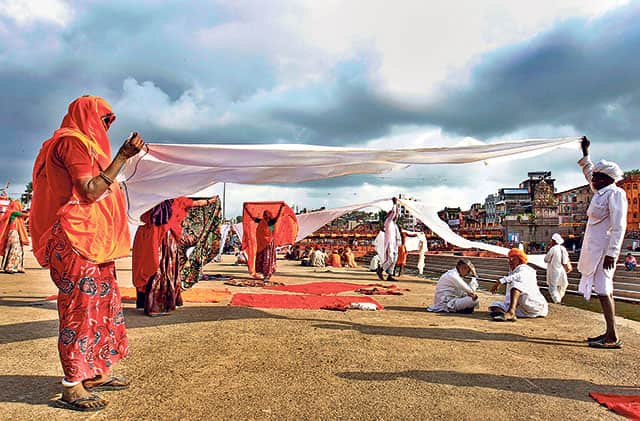Nashik Kumbh: Of selfies, detergents and power struggles
From selfies to power struggles, the Nashik Kumbh Mela is about the pulls and pressures of faith, festivals and organising a mass event.
The virtues of ascetic life and an informal contract for supplying tents, food and water is the talk between Pratik Sharma and Ramcharan Maharaj, the latter a sadhu at the Kumbh Mela, these days. Pratik is a good Nashik boy. He fasts on most Mondays, plays second leads in Marathi black comedies, relies on his father to update him on religious myths and legends. He believes that Ram and Sita, Hinduism's divine couple, spent their exile in Nashik; he has no reason to question this. For Pratik, not unlike many others in Nashik, history and myth are much the same thing; when he is speaking of one, he could very well be talking of the other.
"Ram rajya hua hoga (Ram's reign must have happened)," he says, adding: "But ask Maharajji."
In other words, the questions you can't put to God, you put to a man.
Faith is not in short supply in Nashik, despite the dip in numbers this Kumbh due to rural distress. Locals also complain of congestion and chaos due to the influx of pilgrims.
In pics:
"If your sins worry you so much that you need to bathe in the river with soap and detergent, pay for it. I'm all for pilgrims being charged a salvation tax," says writer Lokesh Shevde. "If I have a scooter, won't I pay parking fees?"
Pilgrims and the attending spectacle, however, do gratify locals at some level; it gives Nashik, sandwiched between the state's commercial hub of Mumbai and its other favourite religious destination, Shirdi, an 'older' civilisational identity: that of being a 100-temple town on the banks of a river said to have been brought down to earth by the Hindu deity Shiva, facilitated by the sage Gautama, son-in-law of Brahma, besides being the exilic home of Ram and Sita. This is enough, at least for the Nashikkars, to consider Nashik a home to the Holy Trinity.
And it is this culture that gives it an extra charge; beats Shirdi, the home of Sai Baba, anytime.

A group of pilgrims in Trimbakeshwar, home to teh source of the Godavari river and the second Kumbh destination in Nashik. (HT Photos/ Ajay Aggarwal)
Nashik is also a centre of scriptural Hinduism (Shukla Yajurveda). As the town is overrun with men in saffron, some locals speak approvingly of the Vishwa Hindu Parishad's religious checklist that keeps sadhus relevant. "The VHP asked sadhus to come out of their religious academies or akhadas and mutts to defend the faith and open social institutions like schools and orphanages," says veteran journalist Arun Khonde.
Twenty-first century pragmatism has, in this way, left its mark on the way a religion like Hinduism has sought to organise itself vis-à-vis questions of faith and its followers. This has no doubt influenced the way festivals like the Kumbh are viewed and celebrated in Nashik.
In pics:
Of the 7 lakh pilgrims this year, down from 12 lakh in 2003, a sizeable number looked as if they were on a picnic. The selfie seemed to have become the reason for the holy dip in many cases.
Spiritual power
The Kumbh, say social commentators, has also become about patronage - political and religious. The Kumbh months are clearly the months to earn. For instance, Pratik, who event-manages for three sadhus, earns Rs 60,000 from odd jobs during this time.
On the back of the 1991 mela, the state government allocated additional funds for the city's development; and Nashik will reportedly get a Rs10-crore development package from ASSOCHAM after the 2015 Kumbh," Khonde says.
Essential civic works like road repairs and water purification around the holy ghats also become political agendas, as leaders seek to woo the religious.
"The Kumbh occurs once in 12 years, and then the city turns 180 degrees," says green activist, Rajesh Pandit. "The Kumbh should be about brainstorming and finding solutions to urgent civic problems."

For many pilgrims, the selfie seems to have become teh reason for the holy dip
Environment speak is common among city officials during this season, but the signs that this is knee-jerk is visible. This is the year of the Green Kumbh, says Sanjay Damdade, a moustachoied corporation official, in between pointing his hand in the direction of the Ganga Godavari shrine and coming down hard on his whistle to stop a tourist from wringing out his underwear in the river.
At his feet, the aquarium-green waters of the Godavari suddenly bubble white. An old woman has just poured in a litre of milk; she scurries away after getting the Damdade glare.
"Milk down a river… not good," says Damdade, smiling sheepishly as strings of marigold eddy down the interconnected bathing areas. "We are against flowers as well."
The other Kumbh
The Kumbh story is actually two stories rolled into one. The first has to do with the birth of the river Godavari in the hill town of Trimbakeshwar (28 km from Nashik), set in a time when, as in the Greek epics, gods were said to move among men.
The second has to do with the resolution of a 1790 conflict between sadhus of the Vaishnav and Shaiva sects, over who would take the holy dip first during the Kumbh. Since then, Vaishnavs do the dip in Nashik; Shaivaites in Trimbak. (This year, too, the ancient quarrel had a re-run, with Trimbak priests and Nashik sadhus tussling over a flag-hoisting ceremony). Trimbak residents, however, insert this fight into a moral framework and go about the holy month with something of a chip on their shoulders.
"After all, this is where the fight for good and evil started, isn't it?" says policeman Sudarshan Awari, guarding the black-stone Shiva shrine, with a smile. The 24 year-old lays down his rifle and tries to be helpful. But above his head the morning sun bears down; he doesn't know where to point. "On August 29, at some point, Jupiter, the Moon and the Sun will be seen in a straight line. Why only on this date, we wonder…."

Pilgrims lay their clothes out to dry on the banks of the sacred river
Surendra Shukla, mechanical engineer-turned-priest, brushes off these doubts. In between the pulls of blind faith and grinning agnosticism that one encounters in Nashik, his faith-is-science-and-vice-versa attitude is interesting. "It's not about being in one line, but about planets entering the zodiac system," says this tall, thin man, who speaks in a precise manner and is a 15th-generation priest.
He stops to take a phone call from Raipur, from a man asking him to organise a ceremony during the Kumbh holy dates to remove his 'father's sin'. What's the fix for such a request?
"Faith makes it work. Religion is about experience," he says. "There is no need for proof."
"I find it hard to believe. I dream things God wouldn't like," I say.
He asks his wife to bring us tea and looks out of the window. "Let's talk about this later," he says. He doesn't need to hear all this at this hour of day.
WHAT IS THE KUMBH?
*
The Kumbh Mela is held every three years in one of four places by rotation - Allahabad in Uttar Pradesh, Haridwar in Uttarakhand, Ujjain in Madhya Pradesh and Nashik in Maharashtra.
*
Its origins are believed to lie in the creation of the river Ganga. Hindu myth tells of how the goddess Ganga emerged from Shiva's locks and came to earth in the form of this sacred river. When Ganga wanted to return to heaven, the sages promised that they would gather on her banks every 12 years in tribute, if she stayed back. These gatherings are the Kumbh.
*
While the Kumbh is celebrated on the banks of the Ganga in UP and Uttarakhand, it celebrates the holy and life-sustaining Shipra river in MP and the similarly sacred Godavari in Maharashtra.
*
The last Kumbh Mela in Nashik was held 12 years ago. Here, holy dips are taken in two places - Nashik and Trimbakeshwar.
*
The Allahabad Kumbh is regarded to be the most famous Kumbh. The Nashik 2015 Kumbh is being held between July 14 and September 25.
*
Nashik's 'sadhu gram' is spread across 283 acres, housing around 1.38 lakh sadhus; Trimbak's is spread across 15 acres.





